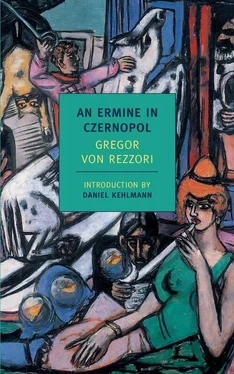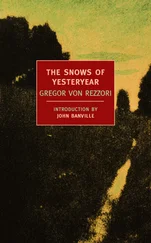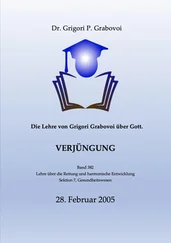Never again would we encounter the same mythological procession of rider and lady, the sumptuously Baroque order, the sleigh gliding silently ahead alongside the whirling bustle of the dogs; the woman in the sled was no longer there, and in her place we most often saw his orderly, and so the days when the hussar rode by were tinged with a special light that lifted them out of the chain of the otherwise uneventful hours of those childhood days — idly frittered away, I’m tempted to say — and preserved their memory as sharply focused individual images in an otherwise inscrutable photograph. Undoubtedly it is always encounters like that, or rather the reencounters, which illuminate certain situations in all detail, like a flashlight, so that what we call memory is really just the recurrence of a few basic motifs, be they images or moods, in constantly changing configurations. Perhaps our soul is capable of little more than tracing the secret essence of these basic motifs through everything it encounters.
As I mentioned, we soon knew our hussar’s name, that he was Nikolaus Tildy, and that he was an officer in one of the cavalry regiments that had moved into the old, former Austrian cavalry barracks on the other side of the Volksgarten, following the occupation of our homeland. We were further delighted to learn that he lived nearby. Now and then we saw his orderly leading a horse into the barracks. We didn’t see the woman in the sled again until later, and then under distressing circumstances.
Meanwhile, something arose between our everyday existence and the world that had produced Tildy, which for us was automatically exotic and full of wonder — something that we interpreted as a secret connection.
In those days, our country’s elaborate, unwieldy approach to managing the economy kept a great many people busy. This was not because this system made our lives any more comfortable; rather it was due to a simple inability to think or even act economically — a failing, by the way, which despite all disadvantages did make our lives unforgettably rich in a way that has since disappeared from the earth entirely. For example, if a man offered his services without specifying precisely what these services might be, perhaps by boasting that he was strong enough to lift heavy objects, then no one questioned whether he was really needed but instead went about finding tasks for him to perform, once he had indeed demonstrated that he was as strong as he claimed. A maidservant was hired because she had made a nice and honest impression with her fresh red cheeks, her clean folk blouse, and her neatly combed hair — despite the fact that we by no means lacked for maids already. Another man found a position as a gardener because his face, bright with a simpleminded cheer and sunny to the point of saintliness, along with his gentle manner of speech, seemed clear proof of a green thumb. He was soon unmasked as an escaped convict and a particularly unscrupulous thief and was handed over to the police — much to our regret, incidentally, because we loved him dearly and wound up losing a great friend.
But such gaps were soon filled. And nothing could shake the attraction we felt for these people who contributed little in the way of service to our household but rather used it as a refuge and a playground for their peculiar idiosyncrasies — just like our poultry yard, which was filled with completely useless ornamental breeds of chickens and ducks, peacocks and pheasants — and we were rewarded with an abundance of experiences and exposed to a rich gallery of people, as colorful and aromatic as a bouquet of grasses and fresh meadow flowers.
Thus had we won the affection of a certain Widow Morar, a person of revolting, virtually monstrous ugliness, who was occasionally hired to help on the big laundry days, although she undoubtedly hindered more than helped with her boundless chatter. But she was a widow with three sons, and people generally pitied her. Everyone was in complete and unquestioning accord that she should be supported, and this had become a permanent arrangement, notwithstanding the fact that her sons were long grown up and gainfully employed — one even as a streetcar conductor — and that she was spending everything she earned on senselessly replacing some of her healthy natural teeth with gold dentures. Her husband, a drunkard, had shot himself.
Driven by a pathological need to communicate, she recounted this drama to us over and over, even bringing as evidence a chromolithograph of Christ, at once unsettling and profound, where a bullet had bored a perfectly circular hole the size of a coin right in the sealing-wax-red heart of the savior — his first shot, which had missed. Herr Morar had shot himself when he was in his cups, and spent a long time clumsily positioning his long military-issue rifle. He was unable to hold the gun with outstretched arms up to his temple. As a result, various projectiles had gone into the walls and ceiling, with him falling down each time in the process. Not until he placed the muzzle of his weapon in his mouth—“like a bottle” is how Widow Morar put it — while lying on his back, and using his big toe to squeeze the trigger, did he manage to kill himself. He had locked his wife and children in the next room; they were able to follow the proceedings through the keyhole.
This ghastly experience, which she could portray to few others so often and in such detail — and which appeared to have left her with an affinity for similarly shattering incidents, because she knew of further gruesome accidents, incurable diseases, and bloody crimes to relate — this experience made Widow Morar so attractive in our eyes that every time she showed up we would sneak away from whoever was watching us in order to get near her. Then she would treat us to macabre depictions that, far from repelling us, absolutely enthralled us, because they dealt with life’s darkest and least comprehensible riddle — death, which even in childhood seemed so close it verged on horror. But her attraction became utterly irresistible when we learned that Widow Morar also helped out at Tildy’s home. What’s more: she could boast of being a close confidante of Madame Tildy — to what degree this was true we will yet discover.
But back then could we have had any doubts? Everything about our hussar and the woman in the sled seemed so much like a fairy tale that we would not have been amazed at all to see these two mixed up in the strangest circumstances — and especially with a woman such as Widow Morar, whose mysterious ugliness made a mockery of any true human form, and put her in the company of djinns, ghosts, and demons from A Thousand and One Nights , not to mention her inner psychological connection to the eerie and the horrible.
In short, what we now heard about the woman in the sleigh, whose face we hadn’t seen, hardly helped bring our fantasies to a more down-to-earth reality. Her beauty was something we took for granted: we had never expected anything else. But just to have something concrete in mind, we asked: “How beautiful is she?”
“As beautiful as your doll with the bird,” said Widow Morar.
And of course we had known all along that she had some secret suffering—“a disease of the heart,” as Widow Morar put it.
“Can a doctor help her?”
“No, said Widow Morar, closing her eyes and smiling knowingly, almost happily. The fire of her gold teeth transformed her amazing ugliness into the mask of a shaman. No, it was not a sickness that could be cured by any human art or wisdom: Madame Tildy was born a Paşcanu.
That was news to us, though not surprising. Who else could the woman be but a daughter of the man whose celebrated rise to immeasurable wealth had made him as legendary as his wild life and, in the end, his grotesque downfall! Naturally, at the time we still had no idea about his touchingly ridiculous and dreadful end; we only knew his name from phrases that had become nearly proverbial: “Rich as Old Paşcanu,” or “a fox, a tiger, a wolf … a real Paşcanu.” Or else: “A peasant, a muzhik with no more manners than old Paşcanu,” and, finally, “as love-crazed as old Paşcanu.”
Читать дальше












